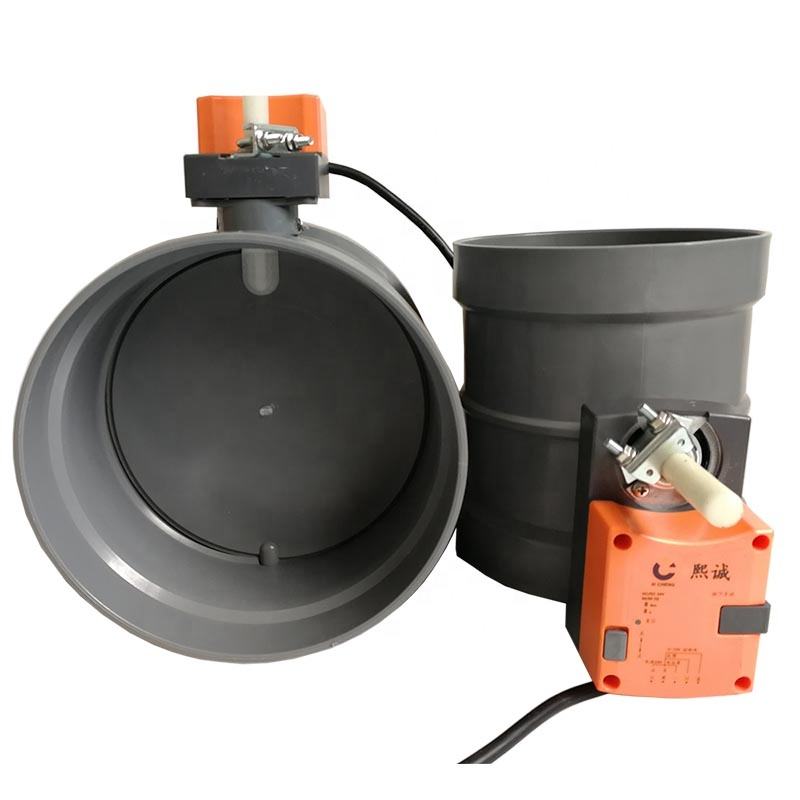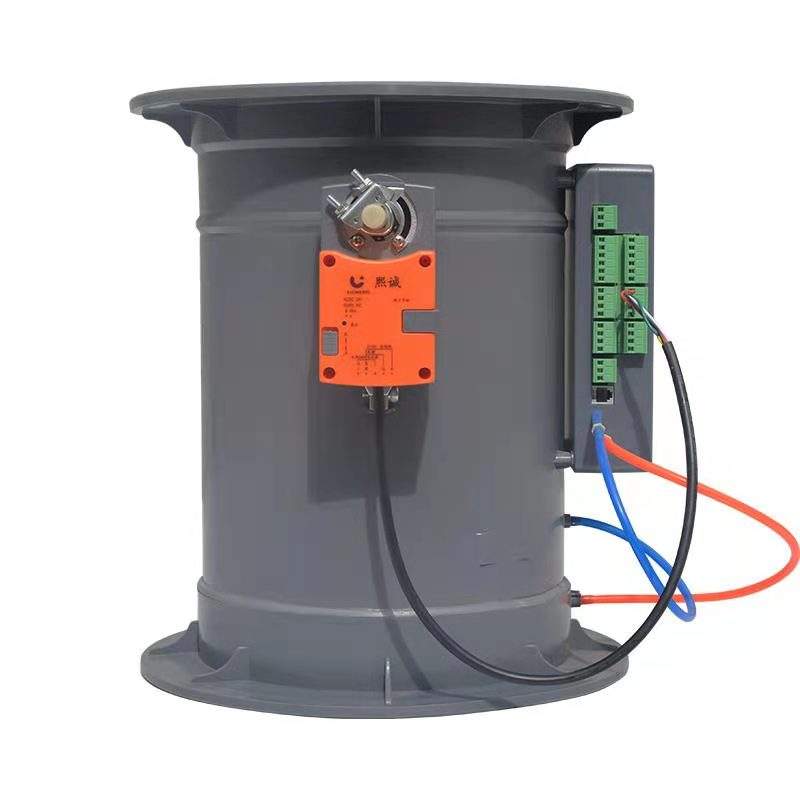The difference between Venturi valve and butterfly valve
Category : Blog
When we discuss butterfly valves in a broad sense, it also includes various fixed air volume butterfly valves, variable air volume butterfly valves (constant air volume valves with actuators), and variable air volume VAV boxes (VAV BOX) modified from butterfly valves.
Criteria for distinguishing between “pressure independent valve” and “common valve”
The primary goal of the laboratory ventilation system is to ensure the safety of the operators. The fume hood system needs to capture and block harmful gases, which requires the control of the surface wind speed of the fume hood. First, the surface wind speed that is too high or too low is unacceptable. , too low will lead to ineffective capture, and too high will lead to turbulence and eddy currents, and will also cause harmful gases to escape. An effective control system needs to avoid the possible situations where the surface wind speed is too high or too low.
Formula: wind speed 0.5m/s ↓= cross-sectional area of viewing window / exhaust air volume ↓
There are two situations in which the exhaust air volume of the fume hood changes:
1. Reasonable variable air volume (VAV):
When the window is raised or lowered, or other factors (such as a larger person reaching the fume hood window) cause the cross-sectional area of the window to change, the “valve” can be “closed down” or “opened up” to change Exhaust air volume, so that the “wind speed on the surface of the exhaust cabinet” is constant;
2. Malignant variable air volume (interference from the main pipe):
When the window is not moved or the surface wind speed is not required to change, the change of wind pressure in the main pipe will also interfere with the “valve” on the top of the fume cupboard. Make the exhaust air volume of the fume hood “changes that should not occur”, thereby affecting the surface wind speed that should be stable at this time;
in conclusion:
A good “valve” can “quickly resolve” the “malignant variable air volume” caused by changes in external air pressure through its own adjustment ability. “Close down” or “Open up” makes the fume hood change the air volume reasonably, and cannot be affected by the pressure change of the outside world (main pipe).
This is what we advocate for the “fume hood valve” should have excellent “pressure independent”.
The difference between the application of “Venturi valve” and “Butterfly valve“

Compared with the butterfly valve, the main advantage of the Venturi valve lies in the two points of “true pressure independence” and “quick response”:
(1) Pressure-independent characteristics: “It should change only when it should change, and it should not change when it should not change”
During the operation of the fume hood, the most important factor affecting the wind speed on the surface of the fume hood is the pressure of the ventilation system pipe network. Due to the opening and closing of other fume hoods or ventilation equipment, or changes in other aspects of the pipe network, the pipe pressure of the fume hood will change. This change happens frequently.
If the fume hood system uses ordinary butterfly valves, the surface wind speed of the fume hood will change frequently, which is very detrimental to the safety of the laboratory. Even if the wind speed control system is used, it will only be adjusted after the surface wind speed changes. It will go through a series of sensing, calculation, adjustment, and oscillation processes, and at this time, the unsafe situation has occurred, because the pressure change of the pipe network may occur at any time, and relying solely on the wind speed control system will lead to slow and frequent control of the surface wind speed.
The fume hood control system using the venturi valve can solve the problem of the pressure change of the system pipe network, and the venturi valve can be automatically adjusted according to the pressure change of the pipe network. This process occurs at the same time with the pressure change of the pipe network, thus avoiding the need to adjust the process by the wind speed control system, and realizing fast and stable air volume control.

(2) Self-regulation “quickly”
In the process of opening or closing the adjustment door of the fume hood, the problem of needing to adjust the exhaust air volume of the fume hood will occur. The structural characteristics of the FDE Venturi valve can ensure its rapid response and adjustment time, usually to achieve its required air volume, which is equally fast in use. In the case of a large actuator, the FDE Venturi valve only requires the actuator to rotate 10 or 20 degrees, while the butterfly valve requires a larger angle.
(3) The ratio of the maximum air volume and the minimum air volume of the Venturi valve is: 20:1
Limitations of Butterfly Valve Users’ “Fixing the Dead”
People who use butterfly valves often take the following remedial measures, hoping to minimize the impact of mains pressure fluctuations on the suction of their fume hoods:
(1) Use a VAV BOX (some people call it a variable air volume adjustment box), and use a pitot tube to measure the air volume to self-adjust
Assemble the “butterfly valve + pitot tube + differential pressure sensor + local controller” together to make a VAVBOX.
When the fume hood is not moving and the air volume should not change, the VAVBOX equipped with the butterfly valve uses the pitot tube to sense the vicious air volume change caused by the pressure fluctuation of the main pipe, and then transmits the data to the small controller through the differential pressure sensor, and the small controller then adjusts the The actuator can be turned on or off, and the small controller belongs to the DDC control principle. The main disadvantage is that the action is slow and requires measurement, calculation and adjustment.
However, the biggest problem with this method is that the pitot tubes used for air volume measurement are directly exposed to the exhaust gas containing dust and magazines, which will soon be blocked and the accuracy will be lost.
Please see! Why is the VAV BOX not suitable for use in the exhaust direction?
Answer: The VAV BOX contains dust-sensitive devices such as pitot tubes, which can quickly fail due to clogging. In addition, no matter how well the VAV BOX is done, the ratio of the maximum air volume to the minimum air volume is only 10:1, which means that the adjustment accuracy is twice as small as that of the Venturi valve.
(2) Use the so-called “variable air volume butterfly valve”:
The so-called “variable air volume butterfly valve” is actually adding an actuator to the “constant air volume butterfly valve”!
Variable air volume butterfly = (constant air volume butterfly valve) + actuator
= (butterfly valve + airbag) + actuator
The constant air volume valve is not suitable for the fume hood. The airbag is installed on the device to achieve the purpose of constant air volume when the fume hood does not require variable air volume. The following figure is the internal schematic diagram of the constant air volume butterfly valve with airbag. When the pressure increases, the airbag expands, pushing the front baffle, reducing the cross-sectional area of the airflow through the butterfly valve.
This product is a cheap product specially “customized” by some foreign constant air volume valve manufacturers for Chinese consumers. Although the price is extremely cheap, it is almost “pressure related”, and there are still many problems in use:
Some “constant air volume butterfly valves” can’t actually be “fixed” at all. The air volume is still fixed with the pressure of the pipe network. The constant air volume valve can be fixed, but it cannot be changed when it should change. That is the real constant air volume valve.
Some “constant air volume butterfly valves” have serious air leakage and cannot be closed even if they want to close. The reason is that the airbags in these butterfly valves called “constant air volume butterfly valves” do not have a fixed elastic coefficient like springs, and the blades of the butterfly valves rotate during the rotation process. The flow curve is also not linear, so its accuracy cannot be guaranteed when applied to a VAV fume hood control system. The airbag is directly in the air flow range, and when the gas contains impurities such as dust, it will block and affect the accuracy. Especially when high temperature or organic gas is discharged, the airbag may be damaged. This type of butterfly valve has the most complaints in the market;
The air volume of some constant air volume valves is as small as 20%, so the adjustment ratio of the maximum air volume and the minimum air volume may be only 5:1.
(3) The pipeline static pressure method (VFD) that the butterfly valve has to use
The system using ordinary butterfly valve can control the pipeline pressure by ensuring the static pressure of the pipeline. The system pipe network pressure is stabilized by measuring, calculating and comparing the static pressure of the pipeline, and controlling the fan. The disadvantages of this method are:
The accuracy is not high, and the implementation cannot be guaranteed. The selection of the pressure point determines the control accuracy of the pressure. However, it is usually difficult to find a suitable point in the pipeline for the pressure of the pipe network, especially when the resistance of each exhaust equipment and the resistance of the pipeline are different. A suitable pressure setpoint cannot be found.
The response is slow. Controlling the fan in this way is a slow process, and the laboratory exhaust air control requires high speed. In this case, it is difficult to achieve the expected control target, and the situation mentioned above will still occur.